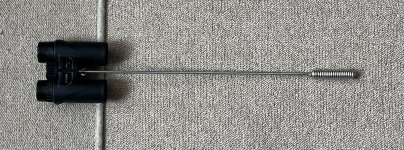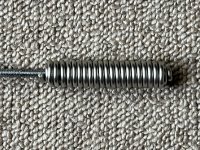kimmik
Well-known member

This thread is for the do-it-yourself, hacker, tinkerer, who has been curious about image stabilised binoculars.
The background for this topic is here: Premium (Alpha) vs Image stabilized




By increasing the Moment of Inertia in the image plane (2 axis stabilisation is all you need, can skip the roll axis), fine tremors are suppressed and the image jitter is reduced. This effect is greatest for high frequency tremors, modest for medium frequency. The stability of above Nikon 8x30, is better than the SLC 8x56 which is the most stable 8x conventional binocular I have ever used.
The rod is 500mm long M6 threaded steel, the tip is lead-free solder that I had, but can be anything you wish for the weight, and the wing-nut helps lock it into place.
Final weight in above build, 610g, same as a Canon 10x30. Removing the stabiliser, the Nikon is 435g.
I don't pretend that this is more effective than active image stabilisation in Canon, or the complex mechanisms in Zeiss, but this is surprisingly effective, simple, and imo elegant by being made of only 3 parts . It definitely has its niche uses for me. Certainly more practical and easier than the skyandtelescope:
. It definitely has its niche uses for me. Certainly more practical and easier than the skyandtelescope:
https://skyandtelescope.org/astronomy-equipment/image-stabilize-your-binoculars/

My hunt for a cheap used pair of canon 10x30 continues as I'm very curious to put them side by side for comparison. Any forum member who wishes to try my stabiliser, I will make you one for free .
.
The background for this topic is here: Premium (Alpha) vs Image stabilized




By increasing the Moment of Inertia in the image plane (2 axis stabilisation is all you need, can skip the roll axis), fine tremors are suppressed and the image jitter is reduced. This effect is greatest for high frequency tremors, modest for medium frequency. The stability of above Nikon 8x30, is better than the SLC 8x56 which is the most stable 8x conventional binocular I have ever used.
The rod is 500mm long M6 threaded steel, the tip is lead-free solder that I had, but can be anything you wish for the weight, and the wing-nut helps lock it into place.
Final weight in above build, 610g, same as a Canon 10x30. Removing the stabiliser, the Nikon is 435g.
I don't pretend that this is more effective than active image stabilisation in Canon, or the complex mechanisms in Zeiss, but this is surprisingly effective, simple, and imo elegant by being made of only 3 parts
https://skyandtelescope.org/astronomy-equipment/image-stabilize-your-binoculars/

My hunt for a cheap used pair of canon 10x30 continues as I'm very curious to put them side by side for comparison. Any forum member who wishes to try my stabiliser, I will make you one for free
Last edited:








